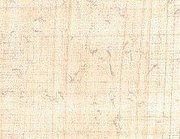Papyrus
|
|
Papyrus is an early form of paper made from the pith of the papyrus plant, Cyperus papyrus, a wetland sedge that grows to 5 meters (15 ft) in height and was once abundant in the Nile Delta of Egypt. Papyrus is first known to have been used in Ancient Egypt (at least as far back as the First dynasty), but it was also widely used throughout the Mediterranean region, as well as inland parts of Europe and south-west Asia.
Etymology
The English word papyrus derives, via Latin, from Greek πάπυρος papuros. It is interesting to note that Greek has a second word for papyrus, βύβλος bublos (said to derive from the name of the Phoencian city of Byblos). The Greek writer Theophrastos, who flourished during the 4th century BC, uses papuros when referring to the plant used as a foodstuff and bublos for the same plant when used for non-food products, such as cordage, basketry, or a writing surface. This latter usage finds its way into English in such words as bibliography, bibliophile, and bible.
It is often claimed that Egyptians referred to papyrus as pa-per-aa [p3y pr-ˁ3] (lit., "that which is of Pharaoh"), apparently denoting that the Egyptian crown owned a monopoly on papyrus production. However no actual ancient text using this term is known. In the Egyptian language papyrus was known by the terms wadj [w3ḏ], tjufy [ṯwfy], and djet [ḏt]. Thus in reality, Greek papuros has no known relation to any Egyptian word or phrase.
Manufacture and Use
A sheet of papyrus is made from the stem of the plant. The outer rind is first stripped off, and the sticky fibrous inner pith is cut lengthwise into thin strips of about 40 cm long. The strips are then placed side by side on a hard surface, with their edges slightly overlapping, and then another layer of strips is laid on top at a right angle. The strips may have been soaked in water long enough for decomposition to begin, perhaps increasing adhesion, but this is not certain. While still moist, the two layers are hammered together, mashing the layers into a single sheet. The sheet is then dried under pressure. After drying, the sheet of papyrus is polished with some rounded object, possibly a stone.
Egypt.Papyrus.01.jpg
To form the long strip that a scroll required, a number of such sheets were united, placed so that all the horizontal fibres parallel with the roll's length were on one side, all the vertical fibres on the other. Greek texts were written on the recto, the lines following the fibres, parallel to the long edges of the scroll. Secondarily, expensive papyrus was often reused, writing across the fibres on the verso [1] (http://www-user.uni-bremen.de/~wie/Egerton/BellSkeat2.html).
In a dry climate like that of Egypt, papyrus is stable, formed as it is of highly rot-resistant cellulose; but storage in humid conditions can result in molds attacking and eventually destroying the material. Imported papyrus that was once commonplace in Greece and Italy has since deteriorated beyond repair, but papyri are still being found in Egypt; extraordinary examples include the Elephantine papyri and the famous finds at Oxyrhynchus and Nag Hammadi. The Villa of the Papyri at Herculaneum, containing the library of Julius Caesar's father-in-law, was preserved by the eruption of Mount Vesuvius, but has only been partially excavated.
In the first centuries BC and AD Papyrus scrolls gained a rival as a writing surface in the form of parchment, which was prepared from animal skins. Sheets of parchment were folded to form quires from which book-form codices were fashioned. Early Christian writers soon adopted the codex form, and in the Gr棯-Roman world it became common to cut sheets from papyrus rolls in order to form codices.
By 800 AD the use of parchment and vellum had replaced papyrus in many areas, though its use in Egypt continued until it was replaced by more inexpensive paper introduced by Arabs. The reasons for this switch include the significantly higher durability of the hide-derived materials, particularly in moist climates, and the fact that they can be manufactured anywhere. The latest certain dates for the use of papyrus are 1057 for a papal decree and 1087 for an Arabic document. Papyrus was used as late as the 1100s in the Byzantine Empire, but there are no known surviving examples.
There have been sporadic attempts to revive the manufacture of papyrus during the past 250 years. The Scottish explorer James Bruce experimented in the late eighteenth century with papyrus plants from the Sudan, for papyrus had become extinct in Egypt. Also in the eighteenth century, a Sicilian named Saverio Landolina manufactured papyrus at Syracuse, where papyrus plants had continued to grow in the wild. The modern technique of papyrus production used in Egypt for the tourist trade was developed in 1962 by the Egyptian engineer Hassan Ragab using plants that had been reintroduced into Egypt in 1872 from France. Both Sicily and Egypt continue to have centres of limited papyrus production.

